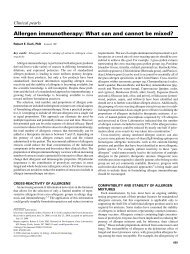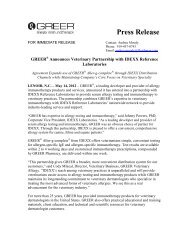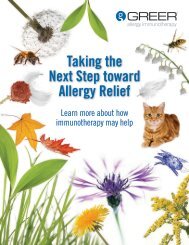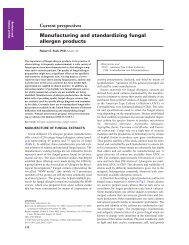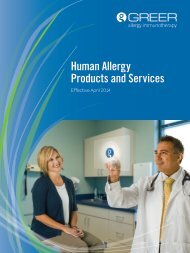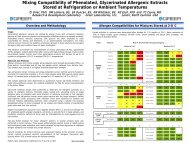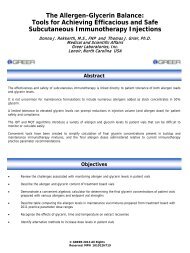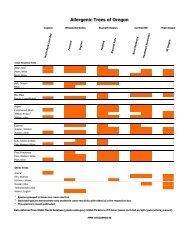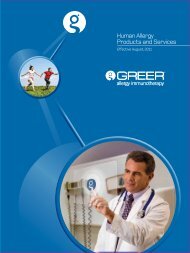allergenic extracts pollens, molds epidermals, insects dusts ... - Greer
allergenic extracts pollens, molds epidermals, insects dusts ... - Greer
allergenic extracts pollens, molds epidermals, insects dusts ... - Greer
You also want an ePaper? Increase the reach of your titles
YUMPU automatically turns print PDFs into web optimized ePapers that Google loves.
There is no evidence of adverse effects of Allergenic Extracts on the fetus. (8)<br />
Studies have not been performed in animals to determine whether <strong>extracts</strong> affect fertility<br />
in males or females, have teratogenic potential, or have other adverse effects on the<br />
fetus. Caution should be exercised in testing or treating pregnant females because a<br />
systemic reaction may cause an abortion as a result of uterine muscle contractions.<br />
LABOR AND DELIVERY: There is no known information of adverse effects during<br />
labor and delivery.<br />
NURSING MOTHERS: It is not known whether this product is excreted in human milk.<br />
Because many drugs are excreted in human milk, caution should be exercised when<br />
<strong>extracts</strong> are administered to a nursing woman.<br />
PEDIATRIC AND GERIATRIC USE: Although most <strong>extracts</strong> have not been studied<br />
systematically in children, children and geriatric patients appear to tolerate injections of<br />
Allergenic Extracts well. Studies with pollenosis and asthma have been conducted in<br />
children (e.g. refs. 19-21) . Extract usage in children should follow the same precautions as in<br />
adults.<br />
ADVERSE REACTIONS<br />
Adverse systemic reactions may occur within minutes upon use of an Allergenic<br />
Extract to which a person has specific sensitivity. These reactions consist primarily of<br />
allergic symptoms such as generalized skin erythema, urticaria, pruritus, angioedema,<br />
rhinitis, wheezing, laryngeal edema, and hypotension. Less commonly, nausea,<br />
emesis, abdominal cramps, diarrhea and uterine contractions may occur. Severe<br />
reactions may cause shock and loss of consciousness. Fatalities have occurred<br />
rarely. (8,22,23) These systemic reactions occur with varying frequency in different clinics<br />
and are usually less than 1%. To some extent, the reaction rate is related to the type<br />
and dose of administered extract and to the sensitivity of the patient. In general,<br />
immunotherapy with Allergenic Extracts is considered to be safe. (24) Despite all<br />
precautions, occasional reactions are unavoidable.<br />
Adverse systemic reactions should be treated as follows:<br />
A. A tourniquet should be immediately applied to the extremity above the site of<br />
injection. Release the tourniquet every few minutes for a few seconds.<br />
B. Epinephrine 1:1000 should be injected immediately in the opposite arm in amounts<br />
of 0.3 to 0.5 mL and 0.2 mL epinephrine should be administered at the site of injection.<br />
For children below the age of 6 years, adjust the dosage of epinephrine to 0.005 mL per<br />
pound of body weight per dose. Repeat epinephrine dosage in 15 minutes if necessary<br />
and if symptoms persist.<br />
C. Adverse reactions not responding to epinephrine therapy may require the use of<br />
parenteral bronchodilators, vasopressors, oxygen, or volume replacement therapy.<br />
Local reactions consisting of erythema, itching, swelling, tenderness and sometimes<br />
pain may occur at the injection site. These reactions may appear within a few minutes<br />
to hours and persist for several days. Local cold applications and oral antihistamines<br />
may be effective treatment. For marked and prolonged local reactions, steroids may be<br />
helpful.



